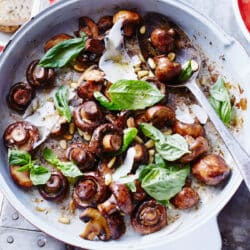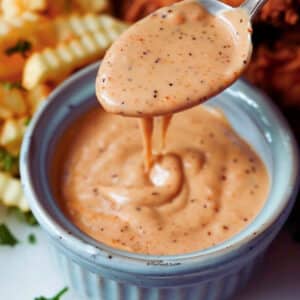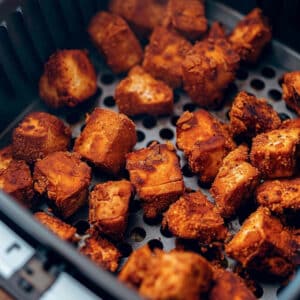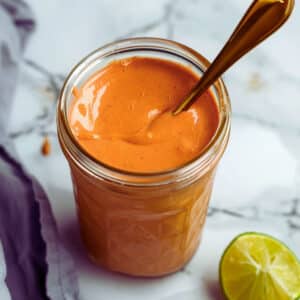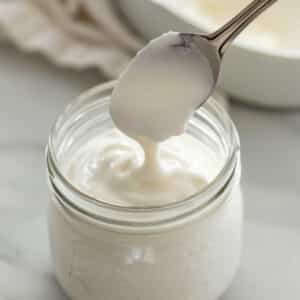Mushrooms are versatile, delicious, and nutritious. They're also very low in calories and easy to prepare. This makes them perfect for those trying to lose weight or eat healthier. In this blog post, I'll show you how to steam mushrooms using a simple method that produces great results every time. Trust me; you won't regret it! So let's get started!

Key takeaways with steamed mushrooms
- The key takeaways with steamed mushrooms are that they are a healthy and flavorful addition to any meal. They cook quickly and easily, making them perfect for busy weeknights.
- Additionally, steamed mushrooms retain more nutrients than other cooking methods, which is a great way to get the most out of your mushrooms.
- Finally, don't forget to season your mushrooms well after steaming them - deglazing with a bit of wine or broth, and adding fresh herbs, can elevate the flavor.
A new way to cook mushrooms
The general rule is that mushrooms must be kept dry, meaning brushing is preferable to soaking or rinsing them— before quickly cooking them without crowding a pan. To clean mushrooms, gently brush away dirt with a soft brush. If you must rinse them, use cold water and dry them immediately with a clean dish towel or paper towel.
The truth is that, as is often the case with kitchen myths, this mushroom myth is wrong. According to this theory, mushrooms function as tiny sponges that soak up water upon contact. Due to their high water content, overcrowd them in a pan or don't cook them fast enough; they'll steam rather than brown.
While it's true that mushrooms are mostly water (about 80 to 90 percent), they also have a high percentage of umami-packed umami compounds. When cooked, these compounds create a flavor that is more intense than their meaty texture would suggest.
In other words, mushrooms taste amazing when cooked the right way. So don't be afraid to add water to the pan when cooking mushrooms. It might be the key to making them even more delicious.
Debunking the myth
Over the years, food scientists and writers realized that the first element of that belief was inaccurate ( you can read the details here). They found steaming or boiling was a perfect way to cook mushrooms—even better than sautéing in some cases.
For one thing, mushrooms contain a lot of liquid. Soak them in water may add extra weight but that amount won't matter compared to how much water they originally had.
There has been more tenacity in the second belief— crowding the pan. It's worth noting that although the International Culinary Center in New York and the blog Cooking issues dispelled the myth a few years ago, many well-known authors and chefs continue to perpetuate it.
I am not one of those people. I have seen firsthand that steaming works just as well whether you crowd the pan or not.
So put as many mushrooms in the steamer as you like. Just make sure they fit snugly so that the steam can circulate. And if you're worried about them shrinking, don't be—they will lose some water weight, but they won't significantly shrink in size.
One more caveat: If you're using an electric steamer, be sure to add the mushrooms after the water has come to a boil. If you add them too early, they will absorb too much water and become mushy.
Mushrooms: The Truth You Need to Know.
In their words, ICC's Dave Arnold and Nils Noren explain that mushrooms that are wet and crowded in the pan will produce something of a soupy liquid as they cook. This isn't necessarily bad, as over time, the water evaporates, and the dish will become a concentrated, flavorful sauce while rendering them brown without soaking up extra oil.
Crowding the pan also allows for more surface area to caramelize, so you're essentially getting a two-for-one in terms of flavor.
On the other hand, a dry mushroom is much more porous than a wet mushroom. Therefore, adding dry mushrooms to a pan with butter or oil, the fat sticks to them. Browned mushrooms turned into greasy ones.
The lesson here? Using the "wet, crowded" method produces mushrooms with a more intense flavor which is evident when cultivated mushrooms are involved. So, don't be afraid to add a little extra water to the pan next time you cook mushrooms. You might just be surprised at the results.
Read:
Steamed mushrooms: How to do it?
Steamed mushrooms are a healthy and delicious way to enjoy mushrooms. They are quick and easy to make and make a great snack or side dish. Cooking mushrooms helps to soften them and brings out their natural flavor. You can add seasonings to the mushrooms after steaming for extra flavor.
Follow the steps on how to do it:
Step 1
Choose the right mushrooms.
Not all mushrooms are created equal—some have a stronger flavor than others. If you're unsure which kind to get, ask your local grocery store or farmer's market vendor for a recommendation.
Using the simple button mushrooms in this recipe was my personal favorite. Despite their low price, they still had a lot of flavors. Try cremini or portobello mushrooms if you want to add more depth of flavor to your dish.
Step 2
Prepare the mushrooms.
Manure-rich soil and plenty of nutrients are typical growing conditions for most commercial mushrooms. One problem is mushrooms can cling to dirt, sand, and grit particles. This can make them quite gritty if not cleaned properly. That's why cleaning them before cooking is essential.
The easiest way is to brush the mushrooms with a soft, dampened brush. Place the mushrooms in a colander, shake them quickly to remove any excess water, and wipe them with a clean, dry cloth or paper towel. You can also rinse them under cold water.
If you're using large mushrooms, you may want to slice or chop them into quarter pieces. They will cook more evenly this way.
Using a colander when washing:
Colanders that fit into bowls are handy because it is easy to put mushrooms in them, fill the bowl with water, and put it in the sink. Allow them to soak for a few minutes, giving them a gentle swirl with your hands if needed.
You can then drain them in a colander. Because soaking mushrooms are perfectly acceptable, it is the quickest and most thorough way to clean them.
You may also mix them directly in water using a bowl, pouring them through a colander. However, if the water is dirty, muddy water will wash over clean mushrooms, requiring another rinse.
Once you have cleaned, trimmed, and cut the mushrooms, remember that when you cook them using this method, you will lose most of the volume, making them much smaller than they started.
Step 3
Steam or boil the mushrooms.
Whenever you shop at a grocery store that only sells mushrooms in 8- or 16-ounce packages, it can be hard to use them up before they go bad. In a two-person kitchen, this can become a big waste of food.
The other benefit of this cooking method is that cooking large amounts at once is best because you want a crowded pan. Once cooked, you'll find that they're easy to use.
Make sure your sauté pan is deep enough to hold all the mushrooms. To use this method, you need to cram them together. You should add water just enough to cover the mushrooms barely. If preparing 8 ounces of mushrooms, stir in 1 tablespoon butter and 1 teaspoon salt. Heat the pan over medium-high heat and bring the water to a rolling boil.
Step 4
Bring the mushrooms to a boil.
If the mushrooms have reached a full boil, reduce the heat, allowing the burner to keep the water boiling rather than simmering. During this step, don't worry about the pan; it's just a matter of waiting for the liquid to evaporate. Water is lost from the mushroom's cells as it cooks. It will be evident to you that the amount of water in the pan has increased since you added it.
Step 5
Sizzle is a good sign.
It won't take long for the mushrooms to sizzle once all the water has evaporated. When this happens, browning them in the pan with leftover butter or oil will give them a deep, rich flavor. Given that the mushrooms are already cooked, this step takes just a minute or two.
The beauty of this method is that it has the advantage of causing the mushroom's cells to rupture and release their air and much of their water, preventing them from absorbing too much oil or fat as they brown. As a result, flavors concentrate, and the texture of the mushrooms becomes firmer and meatier.

Step 6
Add your aromatics.
If you like, add other ingredients to the pan during this final cooking stage. Deglazing the pan with a little wine, dry sherry, or broth and scraping up any brown bits stuck to the bottom will give the dish even more depth of flavor. Adding fresh herbs like rosemary, thyme, and parsley at the end will brighten the flavors.
A splash of soy sauce or Worcestershire sauce, a scattering of fresh herbs, or a minced shallot or garlic clove would all be nice additions. Once the mushrooms are browned to your liking, transfer them to a plate and enjoy.
Step 7
Ready to use in recipes.
Once the mushrooms have been cooked, they are easy to add to all sorts of recipes. Toss them into a salad, wrap them up in a burrito, or top off a pizza. You can also use them as a meatless main course or side dish. No matter how you enjoy them, these mushrooms are sure to please.
With mushrooms being cooked, they are easy to incorporate into recipes. If you won't be using them all immediately, it's best to let them cool and refrigerate for up to five days. The following are worth trying:
- Omelets or scrambled eggs
- Risotto or rice pilaf
- Creamy Chicken Marsala
- Beef Stroganoff
- Chicken À La King
A few tips for cooking and serving:
- In the absence of fresh herbs, leave them out. A dried herb cannot be rehydrated sufficiently. A pinch of red pepper flakes and a little more onion will help.
- Any red or white wine will do, except sweet wines like riesling. If you aren't a wine person, what can you do? You can use beef or chicken broth instead.
- It pairs well with steak, chicken, and vegetarian dishes.
- Put on top of omelets or bruschetta.
Related questions about steamed mushrooms:
How many calories are in steamed mushrooms?
Calories in steamed mushrooms will vary based on the type of mushroom and how it is prepared. For example, an ounce of white button mushrooms has about 8 calories, while an ounce of portobello mushrooms (fat not added while cooking) has about 8 calories.
Are steamed mushrooms healthy?
Mushrooms are a good source of several nutrients, including selenium, potassium, copper, and vitamin D. They also contain antioxidants that may help protect against chronic diseases. While all mushrooms offer some health benefits, those cooked may have higher levels of antioxidants than raw mushrooms.
What is the difference between steamed mushrooms and sautéed mushrooms?
The main difference between steamed mushrooms and sautéed mushrooms is the cooking method. Steamed mushrooms are cooked in water or another liquid, while sautéed mushrooms are cooked in butter or oil. This can affect the texture and flavor of the mushrooms.
Can you reheat steamed mushrooms?
Yes, you can reheat steamed mushrooms. However, they may become tougher and less flavorful if reheated multiple times. If you're not planning to eat them right away, it's best to refrigerate them and enjoy them within 5 days.
What do steamed mushrooms taste like?
There is no one answer to this question, as mushrooms can have various flavors, depending on their type and how they are prepared. Generally speaking, steamed mushrooms tend to taste earthy and slightly sweet. Some people also describe them as being woodsy or nutty. Additionally, the texture of steamed mushrooms can vary depending on how long they are cooked.
For example, longer cooking times will result in softer and more tender mushrooms, while shorter cooking times will leave them with a firmer texture. Ultimately, the taste and texture of steamed mushrooms are something that can be personal to each individual.
How to tell when mushrooms are cooked?
Mushrooms are cooked when they are soft and have lost their firm texture. Additionally, it would be best if you released the juices, and the mushrooms should start to shrink in size. For a quick test of whether your mushrooms are cooked, insert a knife into the center of one. They are done if it slides in easily, and the mushroom starts to fall apart. If the knife doesn't slide in easily or the mushroom feels firm to the touch, you must cook them a bit longer.
What is the best way to store steamed mushrooms?
You can store leftover steamed mushrooms in an airtight container in the fridge for up to 5 days. When reheating, ensure to heat them until they are hot all the way through to avoid food poisoning.
How long do you boil mushrooms?
Mushrooms only need to be boiled for a few minutes, just long enough to evaporate the water content and soften them up. Depending on the size and type of mushroom, this can be anywhere from 2-5 minutes.
Can you overcook mushrooms?
Mushrooms can become overcooked and mushy if they are boiled for too long. Additionally, they can start to release a bitter taste if they are overcooked. For this reason, it's crucial only to boil them for a few minutes and to keep an eye on them to ensure they don't overcook.
What can I do with steamed mushrooms?
Steamed mushrooms can be eaten on their own as a side dish, or you can use them in various recipes. For example, add them to pasta dishes, rice dishes, soups, or salads. Additionally, they can be used as a pizza topping or mixed into sauces and dips. The possibilities are endless!
Bottom line:
This is it if you're looking for a quick and easy way to cook mushrooms. Steaming them first ensures that they'll be perfectly cooked, and browning them in the pan gives them a delicious flavor. Give it a try next time you're looking for an easy side dish or want to add mushrooms to a meal.
Full Recipe
How to cook Steamed Mushrooms
Pin RecipeEquipments:
- Skillet
Ingredients:
- 24 oz mushrooms
- 3 tablespoon butter
Instructions:
Choose the right mushrooms.
- Not all mushrooms are created equal—some have a stronger flavor than others. If you’re unsure which kind to get, ask your local grocery store or farmer’s market vendor for a recommendation.Using the simple button mushrooms in this recipe was my personal favorite. Despite their low price, they still had a lot of flavors. Try cremini or portobello mushrooms if you want to add more depth of flavor to your dish.
Prepare the mushrooms.
- Manure-rich soil and plenty of nutrients are typical growing conditions for most commercial mushrooms. One problem is mushrooms can cling to dirt, sand, and grit particles. This can make them quite gritty if not cleaned properly. That’s why cleaning them before cooking is essential.The easiest way is to brush the mushrooms with a soft, dampened brush. Place the mushrooms in a colander, shake them quickly to remove any excess water, and wipe them with a clean, dry cloth or paper towel. You can also rinse them under cold water.If you’re using large mushrooms, you may want to slice or chop them into quarter pieces. They will cook more evenly this way.
Steam or boil the mushrooms
- Whenever you shop at a grocery store that only sells mushrooms in 8- or 16-ounce packages, it can be hard to use them up before they go bad. In a two-person kitchen, this can become a big waste of food.The other benefit of this cooking method is that cooking large amounts at once is best because you want a crowded pan. Once cooked, you’ll find that they’re easy to use.
- Make sure your sauté pan is deep enough to hold all the mushrooms. To use this method, you need to cram them together. You should add water just enough to cover the mushrooms barely. If preparing 8 ounces of mushrooms, stir in 1 tablespoon butter and 1 teaspoon salt. Heat the pan over medium-high heat and bring the water to a rolling boil.
Bring the mushrooms to a boil.
- If the mushrooms have reached a full boil, reduce the heat, allowing the burner to keep the water boiling rather than simmering. During this step, don’t worry about the pan; it’s just a matter of waiting for the liquid to evaporate. Water is lost from the mushroom’s cells as it cooks. It will be evident to you that the amount of water in the pan has increased since you added it.
Sizzle is a good sign.
- It won’t take long for the mushrooms to sizzle once all the water has evaporated. When this happens, browning them in the pan with leftover butter or oil will give them a deep, rich flavor. Given that the mushrooms are already cooked, this step takes just a minute or two.
- The beauty of this method is that it has the advantage of causing the mushroom’s cells to rupture and release their air and much of their water, preventing them from absorbing too much oil or fat as they brown. As a result, flavors concentrate, and the texture of the mushrooms becomes firmer and meatier.
Add your aromatics.
- If you like, add other ingredients to the pan during this final cooking stage. Deglazing the pan with a little wine, dry sherry, or broth and scraping up any brown bits stuck to the bottom will give the dish even more depth of flavor. Adding fresh herbs like rosemary, thyme, and parsley at the end will brighten the flavors.A splash of soy sauce or Worcestershire sauce, a scattering of fresh herbs, or a minced shallot or garlic clove would all be nice additions. Once the mushrooms are browned to your liking, transfer them to a plate and enjoy.
Ready to use in recipes.
- Once the mushrooms have been cooked, they are easy to add to all sorts of recipes. Toss them into a salad, wrap them up in a burrito, or top off a pizza. You can also use them as a meatless main course or side dish. No matter how you enjoy them, these mushrooms are sure to please.
Notes:
Few tips for cooking and serving:
- In the absence of fresh herbs, leave them out. A dried herb cannot be rehydrated sufficiently. A pinch of red pepper flakes and a little more onion will help.
- Any red or white wine will do, except sweet wines like riesling. If you aren’t a wine person, what can you do? You can use beef or chicken broth instead.
- It pairs well with steak, chicken, and vegetarian dishes.
- Put on top of omelets or bruschetta.
Nutrition Information:
Please note that all nutrition information are just estimates. Values will vary among brands, so we encourage you to calculate these on your own for most accurate results.

